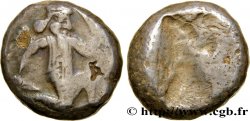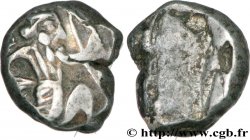v43_0248 - PERSIA - ACHAEMENID KINGDOM - ARTAXERXES II MNEMON Quart de sicle d'argent
MONNAIES 43 (2010)
Starting price : 250.00 €
Estimate : 350.00 €
unsold lot
Starting price : 250.00 €
Estimate : 350.00 €
unsold lot
Type : Quart de sicle d'argent
Date: c. 400-350 AC.
Mint name / Town : Sardes
Metal : silver
Diameter : 8,5 mm
Weight : 1,24 g.
Rarity : R2
Coments on the condition:
Exemplaire frappé sur un petit flan globulaire. Très joli droit, bien centré, pratiquement complet. Revers énigmatique. Recouvert d’une épaisse patine gris foncé
Catalogue references :
Obverse
Obverse legend : ANÉPIGRAPHE.
Obverse description : Le Grand Roi barbu, en archer mélophore, à demi-agenouillé à droite, coiffé de la cidaris, surmontée de cinq dents, vêtu de la candys tirant à l’arc ; le carquois rempli de flèches suspendu à son épaule est bien visible ; ligne de sol.
Reverse
Reverse description : Carré creux allongé, présentant des aspérités irrégulières en forme de chien courant.
Commentary
Ce type bien particulier donné comme un quart de sicle (poids théorique 1,32 g) était attribué par Babelon à Artaxerxès II Mnémon (405-359 avant J.-C.) tandis que David Sear et les auteurs du British Museum l’attribuent à Darius Ier (510-486 avant J.-C.) penchent pour un tiers de sicle (poids théorique 1,76 g). L’exemplaire reproduit dans le catalogue d’Ernest Babelon pèse 1,78 g. Dans son traité, le même Ernest Babelon (p. 61-62, n° 28) attribue une diobole (1,20 g) trouée, conservée à Paris à Artaxerxès III Ochus (359-338 avant J.-C.). Ce type de monnaie divisionnaire est en fait très rare.








 Report a mistake
Report a mistake Print the page
Print the page Share my selection
Share my selection Ask a question
Ask a question Consign / sell
Consign / sell
 Full data
Full data
